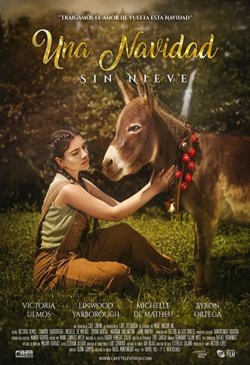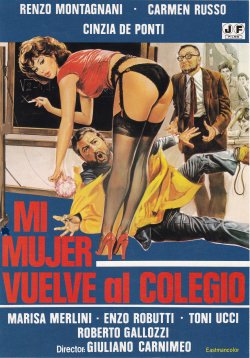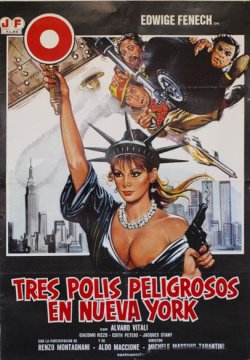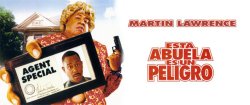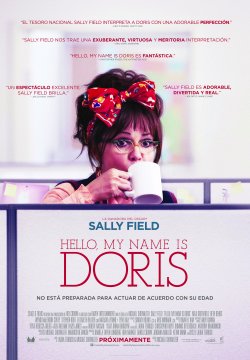 |
|
SINOPSIS
Doris tiene sesenta y algo de años. Un buen día decide inscribirse en un seminario de autoayuda el cual es la inspiración para que comience a perseguir a un joven compañero de trabajo...
INTÉRPRETES
SALLY FIELD, MAX GREENFIELD, BETH BEHRS, WENDI McLENDON-COVEY, STEPHEN ROOT, ELIZABETH REASER, ISABELLA ACRES, KYLE MOONEY, NATASHA LYONNE, TYNE DALY
MÁS INFORMACIÓN DE INTERÉS
![]() CRITICA
CRITICA
![]() BSO
BSO
![]() CLIPS
CLIPS
![]() CÓMO SE HIZO
CÓMO SE HIZO
![]() VIDEO ENTREVISTAS
VIDEO ENTREVISTAS
![]() AUDIOS
AUDIOS
![]() PREMIERE
PREMIERE
 GALERÍA DE FOTOS
GALERÍA DE FOTOS
https://www.cineymax.es/estrenos/fichas/107-h/100125-hello-my-name-is-doris-2015#sigProId338a9bc744
 INFORMACIÓN EXCLUSIVA
INFORMACIÓN EXCLUSIVA
Doris Miller, the heroine of Hello, My Name is Doris, began her cinematic life in an eight-minute film called Doris and the Intern, written and directed by then film student Laura Terruso. Michael Showalter first viewed the short while teaching film at Terruso’s alma mater, the prestigious New York University Tisch School of the Arts. He was immediately struck by the budding writer and director’s inventive sense of humor and fresh outlook on love.
“It was a very funny, very sweet, offbeat little film about a middle-aged office worker named Doris who marches to the beat of her own drummer,” Showalter remembers. “She develops a crush on a teenage intern and when she realizes that it’s unrequited, she steals his bicycle. Doris was a new kind of comedic protagonist with a lot of potential for development.”
Showalter, one of the creators of Wet Hot American Summer as well as a prolific actor, director and producer, is always on the lookout for new and original comic voices. “The character of Doris and her story were new and different,” he says. “To begin with, there aren’t a lot of movies that have an older actress playing the comedic lead role. She is an eccentric and, in a lot of ways, damaged person, but I also saw a great deal that I identified with and I think a lot of other people will, too.”
Eight minutes had given Terruso barely enough time to introduce Doris to an audience, so when Showalter and Terruso began developing the short into a feature film, they opened up the story, exploring different scenarios as they got better acquainted with Doris and her world. “Laura and I spent a lot of time talking about where we could take this,” the director says. “We expanded and refined the story line, added some other characters and spent a lot of time exploring Doris’ life.”
Eventually the pair developed a backstory for Doris that included a lifetime of taking care of her ailing mother and what Showalter likes to call “a clutter habit.” The Miller family home on Staten Island is a living museum, packed with “treasures” that Doris and her
mother have accumulated over the years. “We avoid saying that Doris is a hoarder because that brings in a whole lot of negative innotations that we don’t think apply to her,” says Showalter. “She certainly has a very strong relationship with her possessions. We came up with what we felt was a very authentic, very idiosyncratic way of being. Her wardrobe in particular has agency in the artisanal culture of New York City and she becomes an accidental hipster.”
Doris is a classic outsider, socially isolated by her temperament as well as her responsibilities for her ailing mother. At her job, longtime co-workers have been replaced by younger, hipper colleagues who view her as a vaguely amusing relic. When her mother dies,
she is adrift. For the first time in her life, she is answerable to no one but herself.
“She is somewhat stunted emotionally, which in a lot of ways makes this an archetypal coming-of-age story,” Showalter says. “What happens is that Doris falls in love for the first time and has to learn how to navigate romance. Even though chronologically she is in her 60s, she also has her heart broken for the first time, something that happens to most of most of when we are teenagers.
“In a lot of ways, she’s unscathed by society,” he continues. “There’s a naiveté about her that allows her to do things and say things that are both very funny and surprising, but also speak to her humanity. She still has the idealism of a child. That’s really appealing to me.
She’s not jaded in the way that most of us become as we get older.”
With the character firmly in their sights, Terruso and Showalter passed the script back and forth, developing additional scenes, writing and rewriting. “Our earliest drafts of the movie were more darkly comedic,” says Showalter. “When we started working with Daniela Taplin Lundberg and Riva Marker of Red Crown Films, we began to find more of an arc and a catharsis for the character. We also started to focus on the comic aspects of Doris’ obsessive love for John, which helped us to figure out what is really motivating her."
Bookish, bespectacled and often bewildered by simple social interactions, Doris Miller’s many idiosyncrasies might have been played strictly for comic effect by an actress less sensitive, insightful and compassionate than Academy Award-winner Sally Field. “I can’t
think of many who could capture all of the complexities,” says Showalter. “There is a shy and broken quality to Doris, but she also has enormous inner strength and beauty, real sexuality, offbeat charm and an unexpected fierceness. It’s a lot of components in one character.”
Although Field was at the top of the filmmaker’s wish list to play Doris, with the small budget and limited time in which to shoot, Showalter was not hopeful she would agree.
“She was always our first choice,” he says. “We offered her the part not really expecting her to say yes, but she responded to the character and agreed to do the movie. It was one of the greatest days of my life.”
Field remembers feeling like she was reading something entirely new and different.
“The script was so unusual,” she says. “I’d never come across anything like it. It certainly isn’t a standard mother role. Doris is unique and Michael generously allowed me to help find her. He put this movie together on a dime, but you’d never know that from watching it.”
To Field, Doris is emotionally still very much a teenager, even though she’s closer to retirement age than adolescence. “I thought the script managed to address some of the issues that go along with aging in a really original way,” she notes. “It reminds us that we all
still see our original image of ourselves, no matter what the calendar says.”
Doris, according to Field, is the midst of a huge life transition and her infatuation with her co-worker is part of that. “Trying to find the real emotional components of her life was the biggest challenge of the role,” says Field. “Doris doesn’t follow anyone else’s rules, mostly because she doesn’t know them. She has lived a very cloistered life. She has had the same job for a long time, but the company has transitioned from a traditional kind of a catalogue into an online, cutting-edge thing and now she is surrounded by much younger people. She doesn’t have much money, so she brings home things she finds on the street.
Her mother was probably a hoarder and Doris collected things over the years that have become a substitute for friends.”
Freed from the crushing responsibility of caring for her mother, Doris begins to tentatively explore her options. When John, a new co-worker, gives her just a bit of unexpected attention, she enjoys it so much that she wants more—much more. “She wants to have a real romantic relationship with John,” says Field. “She wants it to evolve into a sexual thing. She wants him to be hers. She wants to be touched. Mostly, she doesn’t want to be alone anymore.”
The story of the film is really the story of Doris finally growing up. “She has to change and her friendship with John, as traumatic as it is, helps her to move on,” Field explains. “I don’t know what happens next. Perhaps she sells her mother’s house, gets an apartment and ends up filling it up in the same way. It’s hard to predict. But this is the first real movement forward she’s been able to take.”
Max Greenfield, who plays John, had previously worked on They Came Together, a comedy co-written by Showalter, starring Paul Rudd and Amy Poehler. “I knew that Max was really good with comedy, but I also believed he would bring some interesting depth to the character.” says Showalter. “He embodies the essential qualities of John. He is strikingly good looking, but also exudes a kind of a sweetness and genuine niceness, which is what gets John into trouble in the first place.”
Field describes Greenfield as a “diamond of a soul.” “I couldn’t have played this part without someone as good and as solid as he is both comedically and dramatically.”
After working with Showalter the writer, Greenfield was eager to see what he would do behind the camera. “When I got the offer to do this movie, I said whatever Michael is doing, I’m in,” he says. “I didn’t even need to see a script. I love Michael’s sensibility, so I
was really excited. His work has a specific tone that I really respond to. He’s brilliant with comedy, but we also got to play more than a few moments that were quite dramatic. It was really satisfying to work through that with Michael and Sally.”
After relocating from Malibu to New York City, John is just finding his footing. “He is starting anew in many ways,” says Greenfield. “He doesn’t really know anybody. On the surface, he seems uber-confident and on top of things, but there is a part of him that is the
new kid in school. He’s looking for a connection and finds one in Doris.”
John and Doris become work friends, but Doris is looking for more. “She becomes a little infatuated,” says Greenfield. “She has such a good heart that he receives that with open arms and is unable to see anything other than the fact that he’s making a new, albeit somewhat unusual, friend.”
For Greenfield, Field’s performance is the soul of the film. “It’s Sally’s movie,” he says. “She set the tone for our scenes and that’s the way it should be. Working with her was just tremendous. It was even more exciting than I imagined and I had high expectations. On
an indie film like this, with little time and so few takes, there are always moments where you’re under the gun. With Sally, I never felt that stress. We just had a really good time.”
Showalter surrounded his two leads with a cast that includes some of the most accomplished actors working today, from veterans including Tony Award®-winner Tyne Daly to newly minted stars like Beth Behrs of the hit sitcom “2 Broke Girls.” “I tried to create a cast that didn’t feel too cool for the movie or for the audience,” he says. “We brought in people who had a real generosity and sweetness about them.”
Behrs plays John’s girlfriend, aptly named Brooklyn, a golden girl who immediately befriends Doris, not realizing she’s the competition in her new friend’s eyes. “I knew Beth’s work,” Showalter says. “We had discussed finding something to work on together and she was perfect for this role. She’s beautiful and extremely charismatic, but also a genuinely nice person. That’s what really attracted me to Beth.”
Daly is a tough broad on the outside but a sentimental softie on the inside as Roz, Doris’ longtime best friend and most loyal defender. “Tyne has always been a favorite actress of mine,” says Showalter. “She was another person who just seemed perfectly suited to the role. Roz is a straight shooter who speaks her mind, but you know that deep down there’s a heart of gold. I was very honored to work with her.”
Field has known Daly since they both began their careers in regional theater. “She’s Tyne Daly,” says Field. “What more do I have to say? She’s fantastic and she always has been.”
Doris’ insensitive brother Todd and his pushy wife Cynthia, played by Stephen Root and Wendi McLendon-Covey, provide comic villains for the audience to root against, says Showalter. “I love Merchant-Ivory-type films set in the 18th and 19th centuries. There are always great supporting characters who come to visit and they’re just mean. I wanted Todd and Cynthia to be like that, but not caricatures. I needed great actors who could bring humor to characters who are vexing for the audience, and I found that in Stephen and Wendi.”
In need of advice on courtship in the digital age, Doris turns to Roz’s 13-year-old granddaughter, Viv, to guide her through the pitfalls of first love and the many uses of social media. “We auditioned many young actresses to play Viv,” says Showalter. “Isabella Acres was actually the very first person who auditioned and we liked her very much. Even though we did lots more auditions, we kept coming back to her. She had the authentic quality that we were looking for.”
Field says the two get along so well because, in a way, they are becoming teenagers together. “She’s so adorable and such a terrific young actress. She just invited me to be her best friend.”
Set in the New York City boroughs of Manhattan, Brooklyn and Staten Island, Hello My Name is Doris was actually shot primarily in Los Angeles. “It was just so much more cost-effective,” Showalter says. “We shot all of the interiors in L.A., but getting the exteriors
right was essential, so we spent one week getting wonderful shots of the Staten Island Ferry and the city, which make it feel like we are actually there.”
Production designer Melanie Jones had to transform the Southern California settings into a believable stand-in for New York’s grittier environs, as well as create a signature look for Doris’ world. John’s quintessential Williamsburg loft is actually in downtown Los
Angeles, as are the offices in which he and Doris work and Brooklyn’s rooftop knitting circle. For the Miller family home, Jones located a house with architecture typical of Staten Island in Highland Park, a neighborhood in northeast Los Angeles.
“It was built in the early 1900s, which is the right period,” she says. “The house was empty, which is a miracle for a location, and it has a very East Coast look. The exciting, and somewhat daunting, challenge was incorporating Doris’ collections. I don’t often come across a script where I get the opportunity to design something this rich and layered.”
The house is a reflection of Doris’ inner life, and the cluttered interior provides clues to who the character really is. Once the basic furniture was in place, Jones and her team set up more than a dozen tables in the backyard, filled with the kinds of tchotchkes that Doris
might have picked up on the street. “Michael and I wanted the house and her collections to show her history,” says Jones. “We started with the idea that Doris’s family had moved in during the 1950s, so you can see that era with layers and layers on top of it.
Jones found Doris’ possessions at thrift shops and prop houses and even her own house. “We had every little thing you could think of,” the designer says. “After the big items were set, we selected this toothbrush or these Christmas-cookie ornaments that were baked
that never got finished. There were teabags, a whole bowl of shampoos and lotions, CDs and records, digital clocks and family photos and on and on. Everything was chosen and placed with a purpose: to try and tell Doris’ story. We called it ‘method-dressing’ the set. It
took us about two days.”
Showalter and Field both felt strongly that Doris’ wardrobe would be a defining element for the film. “A lot of people think of clothes as just a function and wear a basic uniform, but to Doris her clothing is how she communicates her feelings and her moods,” points out Showalter. “There’s a playfulness to the way she dresses. When she goes to the Lower East Side to get a CD by John’s favorite recoding artist, she’s wearing a Sherlock Holmes cape, because she sees it as a secret mission. Whatever she’s doing at any given moment, she needs an outfit that fits it. Getting dressed is like a performance piece for her.
“Her wardrobe is her support network in a lot of ways,” he goes on. “In New York City, you often see fashionistas like that. They’re the little wildflowers growing through the cracks of an asphalt sidewalk. She has funneled all of her passion and imagination and curiosity into the way she dresses.”
Showalter and costume designer Rebecca Gregg looked to real-life New York fashion icons like Iris Apfel during their initial conversations. “People like that are really walking art projects, but we decided that Doris isn’t that academic,” the director says. “She’s more like a found artist. Her influences come from her youth, but like her home, it has layers piled on afterward. I encouraged Rebecca to make as bold a statement as she could. She and Sally together made big, adventurous choices.”
For Gregg, it was a rare opportunity to make the wardrobe a character in itself. “Doris is really a collector of clothing,” she says. “Her clothes are her best friends.”
With almost 50 wardrobe changes for Doris over the course of the film, each made up of multiple layers, Gregg scoured thrift stores, yard sales, flea markets and vintage boutiques to find one-of-kind items like a sweatshirt with a Peter Pan collar, a Mary Poppins-inspired carpet bag and the aforementioned cape. “Sally wore some of her own jewelry and some of my grandma’s jewelry. Each outfit included a scarf, a necklace, a skirt, a blouse and an undergarment, so there were many layers. The more she starts to come out of
her shell, the more colorful she gets.”
Gregg assembled her finds in a huge fitting room at Universal Costume in Los Angeles and spent several days working side by side with Field to create a signature look for Doris. “I think Sally was a little overwhelmed when she saw the sheer volume of stuff we had, but once we got started, she got into it. We came up with some great outfits. Doris has a quirky sense of style that is cool because she doesn’t know it, which endears her to the hipsters of Brooklyn.”
Field describes the process of discovering Doris’ unique look as being a bit like playing dress up. “Rebecca collected the most amazing items from costume houses and thrift stores,” she says. “She went everywhere to find the right wardrobe. The clothes were often quite old and sometimes smelly and ratty and itchy. They didn’t necessarily fit, which was perfect.”
The only costume Field wasn’t sure about was the neon yellow ’80s-era jumpsuit that Doris wears to a concert by John’s favorite band, Baby Goya and the Nuclear Winters, at an ultra-hip Brooklyn nightspot. “That was the only one I balked on, but Michael insisted,” she
says. “I was worried that it was too self-consciously asking for a joke. Michael was certain it had to be that ridiculous. I trusted him finally and having seen it with an audience, I can say he was right. It doesn’t take her out of Doris’ realm. She is pushing the envelope because she wants Max to notice her.”
Doris’ first taste of recognition for her outré style comes during that concert, where Baby Goya himself singles her out and asks her to take part in a photo shoot for the cover of his next album. “The name of the band was something Laura had been toying with for years,” says Showalter. “But that’s actually Jack Antonoff, the lead singer and songwriter for Bleachers, as well as the guitar player and one of the main songwriters of Fun. To his generation, he’s almost like what Elvis Costello was to mine—the smart, cool, offbeat rock star of the era. Jack wrote some amazing songs for the film based on titles Laura and I came up with, like ‘Dance, Rascal, Dance’ and ‘Lasers and Lace.’”
For Showalter, the film is an inspiring combination of humor and heart, with a truly memorable performance at its center. “I want people to come to this film and just enjoy it, but I also want them to see how wonderful Sally Field’s performance is,” says the director.
“She has created an original and unforgettable character. Doris is certainly an unusual protagonist, but we believe everyone can relate to her and what she’s going through. We can see ourselves in her and be uplifted by the notion that it’s never too late to make a change,
it’s never too late to be happy, and everyone deserves that. It’s not about winning the lottery or riding off into the sunset. It’s not the perfect Hollywood ending. It’s about the idea that we can better ourselves if we try hard enough.”






